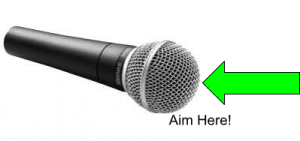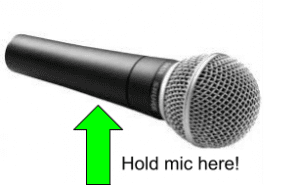Sing it with me! A kiss on the hand may be, quite continental, but MICROPHONES ARE A SINGER’S BEST FRIEND!
That’s how that goes, right? I’m only halfway kidding. The wonderful thing about microphones is that they can make you sound phenomenal. Misuse them though, and you could have a bit of a mess on your hands, metaphorically speaking.
So, what is the best way to use a microphone and how can you make it make you sound even better?
Let’s start with the basics. As a singer, it’s important to know that how and where you place your microphone is essential. First off, your mouth does not need to be ON the microphone (gross) but, it shouldn’t be too far away, either. Think of the microphone like a target and your voice is an arrow.
You can hit the target and not the bullseye and still be fine but, why wouldn’t you want to hit the bullseye? Whether you’re holding the microphone (and there is a right way and wrong way to hold it which we’ll get to in a moment), or it’s being held on a stand, it is essential to have the top of the microphone facing you. Specifically, your mouth. Let’s take a look at a common microphone for a moment:
Where the arrow is, is where your metaphorical “bullseye” is. That is where you want to aim your voice. Most vocal microphones for live performance are unidirectional dynamic microphones. Meaning they pick up the sound in the direction they’re being pointed, cancelling out noises coming from other directions.
When singing in to a microphone on a stand:
You’ll want to make sure the stand is raised to be directly in front of your mouth, and the microphone is pointed straight to your mouth. It is important to note that some singers raise or the stand a few centimeters to ensure they can move their head slightly when trying to hit higher notes. For example, here’s me at my latest show:
(Photo credit: Gerard T. Longo Undergroundmusiccollective.com)
Notice how the top of the microphone is pointed directly at my face and both my drummer and I are aiming our voices at the “bullseye.”
The same rules apply when singing into a microphone that you’re holding. If you’re a mover and a shaker when you sing, or you just like the freedom of holding the microphone, make sure that the top of the microphone is always facing your mouth to get the best sound out of it.
Which brings me to how to hold a microphone properly.
Microphones are inherently, not well balanced tools. Meaning, it’s top heavy. So, our instinct is to hold it at the top which would be slightly correct. However, beginning singers tend to hold the actual top of the microphone instead of the handle. Let’s go back to our microphone picture from earlier and note where the arrow is located:
Just like how you would hold a large water bottle, that’s how you want to hold a microphone. Gripping with your whole hand – first four fingers around the top, and your thumb gripping around the bottom.
Grabbing the microphone by the top or the “grill” leads to muffled sound and/or poor performance on the microphone’s part.
Now let’s get to the fun part: Dynamic Singing with a Microphone
THIS is what you came here for, am I right? Like I said earlier, a microphone is a singer’s best friend! Why? Because of what we can do with it to enhance our performance!
First off, you can utilize so many fun vocal effects using a microphone. (See my article about vocal effects processors to learn more about those!) HELLO reverb!
Secondly, since the main job of a microphone is to amplify your voice for everyone to hear, you don’t have to work as hard to project, leaving you to focus on your technique. (And let all the voice coaches say Hallelujah!)
Lastly, you can move the microphone closer or farther away from your mouth to play with your own dynamics.
Those are just a few examples of the fun tips and tricks you can utilize with a microphone. It is important to point out though, that microphones do have limits which is why you see many powerhouse vocalists pull the microphone away from their face when belting. Not only do they not want to blow out their listener’s ears, they also don’t want to blow out/overload the microphone. That causes feedback, distortion, and a whole other slew of issues you simply don’t need to deal with if you can help it!
As a performer, your microphone is in fact, your best friend. That, and water, technique, good vocal health, etc. It takes a village, right? I digress. Using a microphone to enhance your performance is one of the easiest ways to show that you’re a step ahead as a singer and on your way to being a pro!
Erin Phillips




